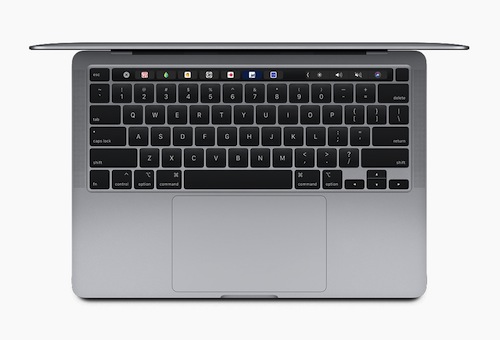
Apple MacBook Pro 13 2020 Photo by Apple
Apple officially announced an updated MacBook Pro 13” today. Some rumors had the new MacBook Pro at 14”, which would have been a replacement for the 13” model. Moving towards a 14” screen is what I have seen various Windows manufacturers do with theirs. Most Windows laptop builders want a 4:3 aspect ratio to fit multiple full sized pages on a screen at one time.
The new models offer the updated 10th gen CPUs, for up to 80% faster graphics performance and makes 16GB of faster 3733MHz RAM memory standard on a few configurations. The new MacBook Pro 13” is available today, starting at $1,200, and $100 less for education customers.
Apple MacBook Air Gold 2020
The new MacBook Pro finally has the new Magic Keyboard, as has been seen in the new MacBook Air 2020 and MacBook Pro 16”. The Magic Keyboard has a redesigned scissor mechanism with 1mm of key travel, which fixes so many of the issues that users of the “butterfly” keyboard faced in the previous MBP 13” models. The Magic Keyboard also features a physical Escape key, along with Touch Bar and Touch ID, for a keyboard that delivers the best typing experience ever on a Mac laptop. The Touch ID feature means that the T2 chip is included in these new models as well.
Apple’s Senior director of Mac ad iPad Product Marketing said, “Whether you’re a college student, a developer, or a creative pro, the 13-inch MacBook Pro delivers powerful performance, a stunning Retina display, and all-day battery life in our most portable pro notebook. Today we’re adding the new Magic Keyboard, doubling the standard storage, and boosting performance, making the 13-inch MacBook Pro an even better value for our customers.” “With these updates, our entire notebook lineup features the Magic Keyboard for the best typing experience ever on a Mac notebook, offers twice the standard storage than before, and delivers even more performance.”
The MacBook Pro 13” now comes with twice the storage of the previous gen, with standard storage starting at 256GB all of the way up to 1TB. Pro users can take advantage of the MBP 13” now offering up to a 4TB SSD.
Up to 10th-gen quad-core Intel Core processors with Turbo Boost speeds of up to 4.1GHz are now available. Customers who are upgrading from a MacBook Pro 13” with a dual-core processor will see up to 2.8 times faster performance.
The integrated Intel Iris Plus Graphics delivers up to 80% faster performance over the previous generation MBP 13” for 4K video editing, faster rendering, and smoother gameplay. The new graphics also enable users to connect to Apple’s ridiculously priced, Pro Display XDR at its full 6K resolution.
16GB of faster 3733MHz RAM memory is now offered as a standard config on select models, and for the first time on a Mac notebook at 13”, a 32GB RAM memory option is also offered. This is good news as some Android smartphones carry 12GB of RAM.
Pricing and Availability
Starting at $1,299 in the US, and $100 less for US education pricing, the new MacBook Pro 13” is available to order today on Apple’s website and in the Apple Store app. It will begin arriving to customers and will be in select Apple Stores and Apple Authorized Resellers later this week. Other pertinent details relating to this line of MacBook Pros can be found on Apple’s website under the Mac section.